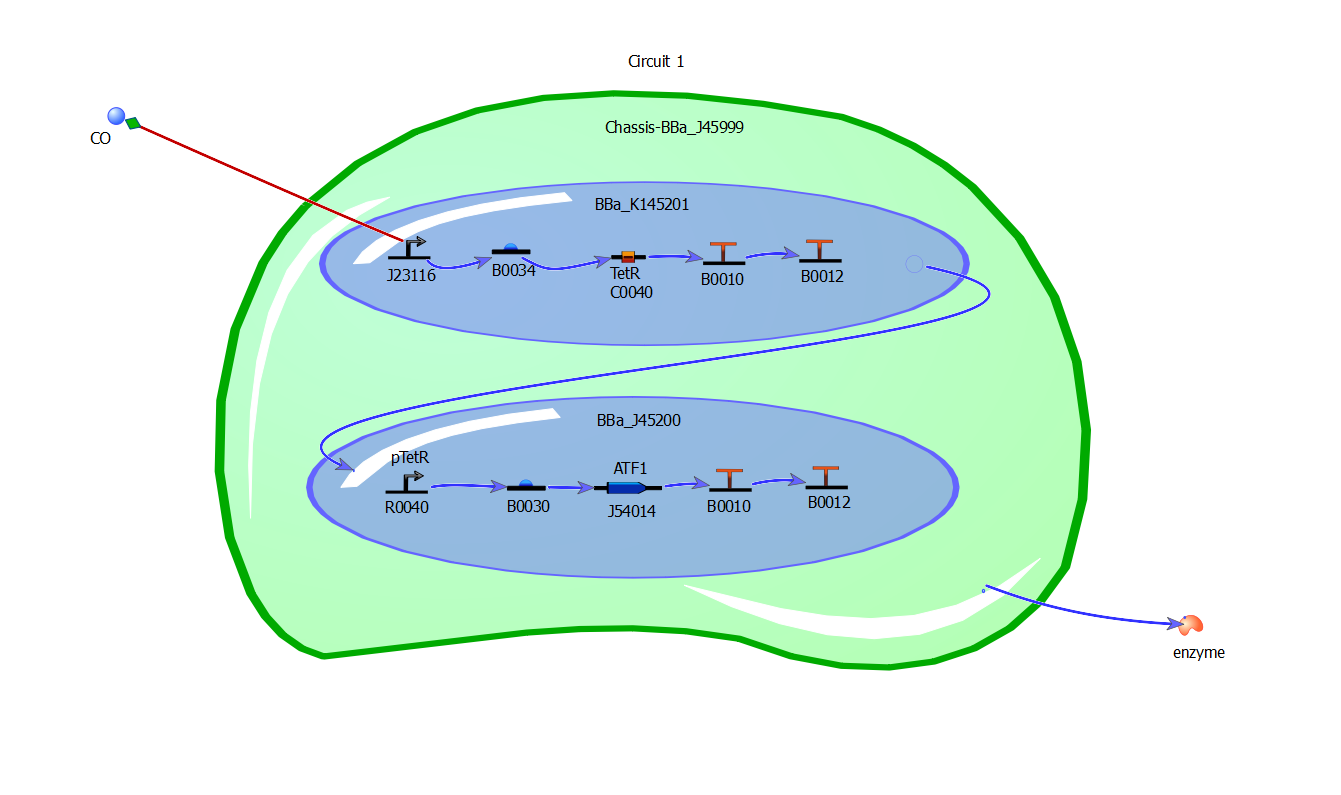CREATING THE GENETIC CIRCUIT
From 2012hs.igem.org
(→Parts We are Considering) |
|||
| Line 9: | Line 9: | ||
[[File:Cell1a.png]] | [[File:Cell1a.png]] | ||
| - | ==== | + | ====Our Circuits==== |
| - | + | '''Chassis''' (for both circuits) | |
| - | + | BBa_J45999 – MIT’s odor free E. coli chassis. | |
| - | + | ||
| - | |||
| - | + | '''Circuit One''' | |
| + | BBa_K145201 - INPUT TetR constitutive generator. TetR will repress transcription from a TetR repressible promoter. Kanamycin resistance available. | ||
| - | + | BBa_J45200 – Banana odor generator. Includes TetR repressible promoter. Ampicillin and tetracycline resistance available. | |
| - | + | (Note: Another method of this system may be connecting the R0040 promoter from K145201 and directly attaching it to J45199, which would make the TetR promoter directly connected to the banana odor generator.) | |
| - | + | This first circuit is our ‘proof of concept,’ designed to show that the ‘on/off’ switch can be used to control a system’s output. Without doxycycline, K145201 is allowed to run and creates TetR. J45200 has a TetR repressible promoter, meaning when TetR is present it doesn’t run and therefore doesn’t produce a banana smell. However, when K145201 is deactivated by the presence of doxycycline TetR is not produced and J45200 is allowed to run, so the isoamyl alcohol is converted into isoamyl acetate by the protein produced by J45200, and a banana smell is detected. | |
| - | |||
| - | + | '''Circuit Two''' | |
| + | BBa_K352015 - CooA coupled with placI+RBS+Double Terminator – Turkey’s CO detecting part, version that includes RBS and terminating sequences. Not available. | ||
| - | + | BBa_K352003 - pCooM Promoter from Rhodospirillum rubrum – Promoter from R. rubrum to go with K352015. Available. | |
| + | |||
| + | BBa_J45199 – Banana odor generator, no tetR repressible promoter. | ||
| + | |||
| + | This circuit is designed to be our ‘real’ carbon monoxide detector. | ||
====Protocol==== | ====Protocol==== | ||
Revision as of 03:11, 24 May 2012
Creating the Genetic Circuit
Once we had our idea solidified, the next step was coming up with a circuit to make our idea into a reality. Using the [http://www.tinkercell.com/ TinkerCell] program to create an example of the cell, we wanted to follow the KISS rule and keep things as simple as possible. The 2010 METU iGEM team created a [http://partsregistry.org/wiki/index.php?title=Part:BBa_K352014 part] that successfully detected carbon monoxide, and contained a Lacl promoter, RBS, and CooA, but from that point what the output was seemed to be fairly open for change. We wanted the output smell to be very unpleasant and trigger a negative response, and decided indole, the smell naturally made by e. coli, would be an excellent choice. We chose tnaA, the indole producing gene, as the last major step in our genetic sequence, and an [http://partsregistry.org/wiki/index.php?title=Part:BBa_J45999 odorless chassis] so that indole wouldn't be naturally produced by the detector.
Obstacles in creating the circuit were finding a tnaA producing gene (still working on that) and...
The parts chosen were all marked as 'working' in the parts registry, and most had the same assembly methods, making them compatible. Our major concerns are that we won't be able to find a tnaA gene by itself, or that the parts chosen won't work be compatible in practice.
Also, special thanks go out to our iGEM advisers, Alyssa Henning, !

Our Circuits
Chassis (for both circuits) BBa_J45999 – MIT’s odor free E. coli chassis.
Circuit One
BBa_K145201 - INPUT TetR constitutive generator. TetR will repress transcription from a TetR repressible promoter. Kanamycin resistance available.
BBa_J45200 – Banana odor generator. Includes TetR repressible promoter. Ampicillin and tetracycline resistance available.
(Note: Another method of this system may be connecting the R0040 promoter from K145201 and directly attaching it to J45199, which would make the TetR promoter directly connected to the banana odor generator.)
This first circuit is our ‘proof of concept,’ designed to show that the ‘on/off’ switch can be used to control a system’s output. Without doxycycline, K145201 is allowed to run and creates TetR. J45200 has a TetR repressible promoter, meaning when TetR is present it doesn’t run and therefore doesn’t produce a banana smell. However, when K145201 is deactivated by the presence of doxycycline TetR is not produced and J45200 is allowed to run, so the isoamyl alcohol is converted into isoamyl acetate by the protein produced by J45200, and a banana smell is detected.
Circuit Two
BBa_K352015 - CooA coupled with placI+RBS+Double Terminator – Turkey’s CO detecting part, version that includes RBS and terminating sequences. Not available.
BBa_K352003 - pCooM Promoter from Rhodospirillum rubrum – Promoter from R. rubrum to go with K352015. Available.
BBa_J45199 – Banana odor generator, no tetR repressible promoter.
This circuit is designed to be our ‘real’ carbon monoxide detector.
Protocol
We are considering the following protocols for preparing our competent cells and preforming our transformation:
[http://partsregistry.org/Help:Protocols/Competent_Cells Competent Cells]
[http://partsregistry.org/Help:Protocols/Transformation Transformation]
Here is the standard procedure we are considering for building our biobrick:
[http://partsregistry.org/Assembly:Standard_assembly Biobrick Assembly]
Click here to see our SAFETY page
 "
"